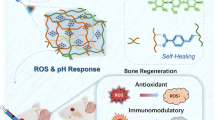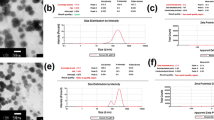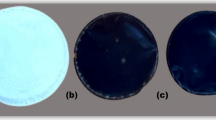Abstract
Aim:
Localized delivery of growth factors has significant potential as a future therapeutic strategy in tissue engineering and regenerative medicine. A nanoparticle vehicle was created and evaluated in this study with the intent to deliver growth factors for periodontal regeneration.
Methods:
Novel composite nanoparticles based on glycidyl methacrylate derivatized dextrans (Dex-GMA) and gelatin were fabricated by a facile method without using any organic solvents. The configurations of the resultant nanoparticles were evaluated by transmission electron microscopy, scanning electron microscopy, and atomic force microscope. Their surfaces were characterized by zeta-potential measurements, after which their properties including swelling, degradation, drug release, and cytotoxicity were also investigated using in vitro models.
Results:
The particle size of Dex-GMA/gelatin nanoparticles (DG-NPs) ranged from 20 to 100 nm and showed a mono-disperse size distribution (mean diameter 53.7 nm) and a strongly negative surface zeta potential (−20 mV). The DG-NPs were characterized by good swelling and degradation properties in media including dextranase. The in vitro drug release studies showed that the efficient bone morphogenetic protein (BMP) release from DG-NPs was maintained for more than 12 d under degradation conditions, where more than 90% of the loaded BMP was released. No any relevant cell damage caused by DG-NPs was found in the cytotoxicity tests for a period of 24 h.
Conclusion:
These combined results demonstrate that DG-NPs fulfill the basic prerequisites for growth factor delivery. With further in vivo studies, those nanoparticles may offer a promising vehicle for the delivery of active drugs to the periodontium.
Similar content being viewed by others
Introduction
The objective of regenerative medicine is to induce the repair of defective tissues based on the natural healing potential of patients. For successful tissue regeneration, it is indispensable to provide local cells with a natural cellular microenvironment by providing an artificial extracellular matrix (ECM) and by delivering growth factors; in such environment, cells can proliferate and differentiate efficiently1. The localized delivery of bioactive molecules is known to be key to this microenvironment, and a desired release technology often enhances the in vivo stability of growth factors and prolongs the maintenance of biological functions for tissue regeneration. Nonetheless, optimal methods of delivery remain to be identified2, 3.
Among the possible strategies to achieve sufficient bioactivity and bioavailability of growth factors for tissue engineering and regeneration, nanoparticulate carriers synthesized from biodegradable polymers represent an exciting approach to increase the uptake and transport of locally administered therapeutic molecules4, 5. While biodegradable nano/microparticles of poly(D,L-lactide-co-glycolide) (PLGA) and PLGA-based polymers have been widely explored as carriers for the controlled delivery of macromolecular therapeutics (eg, proteins, peptides, vaccines, genes, antigens, and growth factors)4, we are interested in develo** growth factor carriers from naturally derived biomaterials like polysaccharides and gelatins. These materials have demonstrated biocompatibility (accepted by the US Food and Drug Administration) and have shown a number of physico-chemical properties that make them suitable for different clinical applications in drug delivery systems6, 7, 6, 9.
Using a facile self-assembly-assisted approach, Dex-GMA/gelatin nanoparticles were successfully synthesized in the present study directly from monomers without the use of any organic solvents or surfactants. The resultant nanoparticles had a strongly negative zeta potential (−20 mV), which can be attributed to the electrostatic repulsion of basic charged gelatin located near the surface. The structure of the nanoparticles may consist of a dextran-based core with an outer gelatin shell. The zeta potential value is an important particle characteristic because it can influence particle stability. Electrostatic repulsion between particles with the same electric charge prevents the aggregation of these particles14. To investigate the distribution of gelatin on the surface, the nanoparticles were suspended in buffers of varying pH values (pH 4–8) and the zeta potential was then determined. The zeta potential did not change at pH values ranging from 5 to 8. However, it increased with a decrease in pH from 4 to 5 and reached −7 mV at a pH of 4. The change in the zeta potential might be due to the ionization of gelatin located near the surface, but such a core-shell configuration requires more convincing evidence. During the swelling and degradation tests, we observed a phenomenon very similar to that was found in the dextran-co-gelatin microspheres investigated in our previous studies7, 9. DG-NPs are only degraded in PBS in the presence of dextranase, and good agreement between the experimentally measured and theoretically presumed protein release kinetics was obtained.
The entrapment of BMP onto the nanoparticles was successfully achieved in our study. In comparison to unloaded nanoparticles, the BMP-loaded nanoparticles did not change significantly with regard to particle size and showed a monomial size distribution. Our results demonstrated that the entrapment efficiency of BMP was significantly dependent on the conjugation method (ie, immobilization or encapsulation). It can be surmised that the IE was mainly determined from the surface area of the DG-NPs. In the case of BMP surface immobilization, the theoretical amount of BMP immobilized onto the surface may increase as particle size decreases. In fact, the IE we observed had a maximum of roughly 100 μg of BMP per milligram of DG-NP. When we used the encapsulated method, the amount of BMP encapsulated into the nanoparticles was roughly 250 μg per milligram of DG-NPs at maximum(initial BMP concentration 2 mg/mL). The loading capacity of BMP into the nanoparticles was significantly higher than the maximum amount of BMP immobilized onto the surface (P<0.01). Therefore, we conclude that the inner space of the nanoparticles had great potential to load the proteins. This result indicates that encapsulation, in contrast to surface immobilization, appeared to be the main mechanism for loading protein. Surface immobilization should be the first choice when the bioactivity of the loaded proteins is taken into consideration, however, provided that 1) drug loading can meet the requirements of the final applications and 2) the immobilized mechanism can provide sustained drug release for the required period.
The interaction between BMP and the nanoparticles is very stable, possibly due to electrostatic interactions between the acidic BMP and the basic gelatin groups12. The gelatin used in this study had an IEP of 8.5 and was thus a “basic” gelatin. As a result, BMP (with an IEP of about 5.0) can be well absorbed to the basic gelatin hydrogel with time during both entrapment processes. This can be explained in terms of the electrostatic interaction between the positively charged growth factors and the gelatin9, 12. For this reason, our final BMP immobilization levels reached roughly 100 μg of BMP per milligram of DG-NPs. Dextran is a natural polysaccharide, and the characteristic α-1,6-glucosidic linkage is hydrolyzed by dextranase11. Experiments have indicated that derivative dextrans can also be degraded by dextranase and that an increasing degree of substitution results in a slower degradation rate11. We hope to use the advantages of both gelatin (ie, ionic interaction between oppositely charged molecules) and dextran (ie, enzyme degradation without rapid solubilization) to generate an enhanced composite biomaterial that can release drug molecules in the colon after hydrolysis of the polysaccharide nanoparticles by dextranase.
As anticipated, less than 20% of the incorporated BMP was desorbed from DG-NPs within the initial 24 h under in vitro non-degradation conditions (PBS in the absence of dextranase). This was followed by a lack of further substantial desorption, whereas a large initial desorption of incorporated drugs was observed for simplex dextran-derived microspheres17. While work continues to improve its release technology through the use of composite scaffolds and biomaterial modification, more studies are required to characterize the sorption and release profiles of a wider variety of biomolecules from this carrier18, 19. The utility and potential of nanoparticle drug delivery systems have been demonstrated, and it has been shown that tailored delivery is possible20, 21, 22, 23. Many chemical and engineering questions specific to these designed systems have been addressed24, 25. The broad scope application of micro/nano-systems requires testing in case-by-case studies, and it may not always be clear how systems will perform during in vivo tests compared to controlled, laboratory environments26, 27, 28, 29. However, synthesizing delivery systems for active drugs and promoting their application for the treatment of different bone defects is a realistic prospect.
Conclusion
Novel dextran- and gelatin-based copolymers formed nanoparticles with a mean diameter of roughly 53.7 nm and a mono-dispersed size distribution when prepared using a facile synthesis method assisted by self-assembly. The DG-NPs showed a highly negative zeta potential in PBS. BMP was successfully entrapped onto these nanoparticles and demonstrated sustained release for 12 d under degradation conditions. In vitro cytotoxicity testing showed that the present nanoparticles did not induce any cytotoxicity against PDLCs. Thus, these DG-NPs may be considered promising biodegradable and biocompatible protein carriers for modulated biodistribution as well as site- and/or cell-specific drug delivery systems. With further studies, these nanoparticles may have the potential to serve as candidate growth factor-vehicles for periodontal tissue regeneration enhancement.
Author contribution
Dr Fa-ming CHEN and Prof Zhi-fen WU designed the research; Dr Fa-ming CHEN, Dr Zhi-wei MA, and Prof Guang-ying DONG performed the research; Dr Fa-ming CHEN analyzed the data; Dr Fa-ming CHEN and Dr Zhi-wei MA wrote the paper.
References
Tabata Y . Significance of release technology in tissue engineering. Drug Discov Today 2005; 10: 1639–46.
Vasita R, Katti DS . Growth factor-delivery systems for tissue engineering: a materials perspective. Expert Rev Med Devices 2006; 3: 29–47.
Chen FM, Shelton RM, ** Y, Chapple IL . Localized delivery of growth factors for periodontal tissue regeneration: role, strategies, and perspectives. Med Res Rev 2009; 29 (in print). doi: 10.1002/med.20144.
Mundargi RC, Babu VR, Rangaswamy V, Patel P, Aminabhavi TM . Nano/micro technologies for delivering macromolecular therapeutics using poly(D,L-lactide-co-glycolide) and its derivatives. J Control Release 2008;125: 193–209.
Jabr-Milane L, van Vlerken L, Devalapally H, Shenoy D, Komareddy S, Bhavsar M, et al. Multi-functional nanocarriers for targeted delivery of drugs and genes. J Control Release 2008; 130: 121–8.
Chen FM, Wu ZF, Wang QT, Wu H, Zhang YJ, Nie X, et al. Preparation and biological characteristics of recombinant human bone morphogenetic protein-2-loaded dextran-co-gelatin hydrogel microspheres, in vitro and in vivo studies. Pharmacology 2005; 75: 133–44.
Chen FM, Wu ZF, Wang QT, Wu H, Zhang YJ, Nie X, et al. Preparation of recombinant human bone morphogenetic protein-2 loaded dextran-based microspheres and their characteristics. Acta Pharmacol Sin 2005; 26: 1093–103.
Chen FM, Wu ZF, Sun HH, Wu H, **n SN, Wang QT, et al. Release of bioactive BMP from dextran-derived microspheres: a novel delivery concept. Int J Pharm 2006; 307: 23–32.
Chen FM, Zhao YM, Wu H, Deng ZH, Wang QT, Zhou W, et al. Enhancement of periodontal tissue regeneration by locally controlled delivery of insulin-like growth factor-I from dextran-co-gelatin microspheres. J Control Release 2006; 114: 209–22.
Huang S, Deng T, Wu H, Chen F, ** Y . Wound dressings containing bFGF-impregnated microspheres. J Microencapsul 2006; 23: 277–90.
Tang MH, Dou HJ, Sun K . One-step synthesis of dextran-based stable nanoparticles assisted by self-assembly. Polymer 2006; 47: 728–34.
Young S, Wong M, Tabata Y, Mikos AG . Gelatin as a delivery vehicle for the controlled release of bioactive molecules. J Control Release 2005; 109: 256–74.
Basinska T, Slomkowski S . The direct determination of protein concentration for proteins immobilized on polystyrene microspheres. J Biomater Sci Polym Ed 1991; 3: 115–25.
Feng SS, Huang G . Effects of emulsifiers on the controlled release of paclitaxel (Taxol) from nanospheres of biodegradable polymers. J Control Release 2001; 71: 53–69.
Panyam J, Labhasetwar V . Biodegradable nanoparticles for drug and gene delivery to cells and tissue. Adv Drug Deliv Rev 2003; 55: 329–47.
Biondi M, Ungaro F, Quaglia F, Netti PA . Controlled drug delivery in tissue engineering. Adv Drug Deliv Rev 2008; 60: 229–42.
Wu H, Zhang Z, Wu D, Zhao H, Yu K, Hou Z . Preparation and drug release characteristics of **yangmycin-loaded dextran cross-linked gelatin microspheres for embolization therapy. J Biomed Mater Res B Appl Biomater 2006; 78: 56–62.
Chen FM, Zhao YM, Sun HH, ** T, Wang QT, Zhou W, et al. Novel glycidyl methacrylated dextran (Dex-GMA)/gelatin hydrogel scaffolds containing microspheres loaded with bone morphogenetic proteins: formulation and characteristics. J Control Release 2007; 118: 65–77.
Chen FM, Zhao YM, Zhang R, ** T, Sun HH, Wu ZF, et al. Periodontal regeneration using novel glycidyl methacrylated dextran (Dex-GMA)/gelatin scaffolds containing microspheres loaded with bone morphogenetic proteins. J Control Release 2007; 121: 81–90.
Huang M, Wu W, Qian J, Wan DJ, Wei XL, Zhu JH . Body distribution and in situ evading of phagocytic uptake by macrophages of long-circulating poly (ethylene glycol) cyanoacrylate-co-n-hexadecyl cyanoacrylate nanoparticles. Acta Pharmacol Sin 2005; 26: 1512–8.
Jiang B, Hu L, Gao C, Shen J . Crosslinked polysaccharide nanocapsules: preparation and drug release properties. Acta Biomater 2006; 2: 9–18.
Huang ZR, Hua SC, Yang YL, Fang JY . Development and evaluation of lipid nanoparticles for camptothecin delivery: a comparison of solid lipid nanoparticles, nanostructured lipid carriers, and lipid emulsion. Acta Pharmacol Sin 2008; 29: 1094–102.
Satarkar NS, Zach Hilt J . Hydrogel nanocomposites as remote-controlled biomaterials. Acta Biomater 2008; 4: 11–6.
Zhang J, Misra RD . Magnetic drug-targeting carrier encapsulated with thermosensitive smart polymer: core-shell nanoparticle carrier and drug release response. Acta Biomater 2007; 3: 838–50.
Zhang J, Rana S, Srivastava RS, Misra RD . On the chemical synthesis and drug delivery response of folate receptor-activated, polyethylene glycol-functionalized magnetite nanoparticles. Acta Biomater 2008; 4: 40–8.
Li SH, Cai SX, Liu B, Ma KW, Wang ZP, Li XK . In vitro characteristics of poly(lactic-co-glycolic acid) microspheres incorporating gelatin particles loading basic fibroblast growth factor. Acta Pharmacol Sin 2006; 27: 754–9.
Juillerat-Jeanneret L, Schmitt F . Chemical modification of therapeutic drugs or drug vector systems to achieve targeted therapy: looking for the grail. Med Res Rev 2007; 27: 574–90.
Cui LJ, Sun NX, Li XH, Huang J, Yang JG . Subconjunctival sustained release 5-fluorouracil for glaucoma filtration surgery. Acta Pharmacol Sin 2008; 29: 1021–8.
Bailey MM, Berkland CJ . Nanoparticle formulations in pulmonary drug delivery. Med Res Rev 2009; 29: 196–212.
Acknowledgements
This project was supported by a grant from the Chinese National Natural Science Foundation (No 30700173), as well as grants from the contributor's own institution.
Author information
Authors and Affiliations
Corresponding author
Rights and permissions
About this article
Cite this article
Chen, Fm., Ma, Zw., Dong, Gy. et al. Composite glycidyl methacrylated dextran (Dex-GMA)/gelatin nanoparticles for localized protein delivery. Acta Pharmacol Sin 30, 485–493 (2009). https://doi.org/10.1038/aps.2009.15
Received:
Accepted:
Published:
Issue Date:
DOI: https://doi.org/10.1038/aps.2009.15
- Springer Nature Singapore Pte Ltd.
Keywords
This article is cited by
-
Recent developments of biomaterial scaffolds and regenerative approaches for craniomaxillofacial bone tissue engineering
Journal of Polymer Research (2022)
-
Recent Trends in Drug Delivery System Using Protein Nanoparticles
Cell Biochemistry and Biophysics (2014)
-
Bone regeneration: current concepts and future directions
BMC Medicine (2011)




